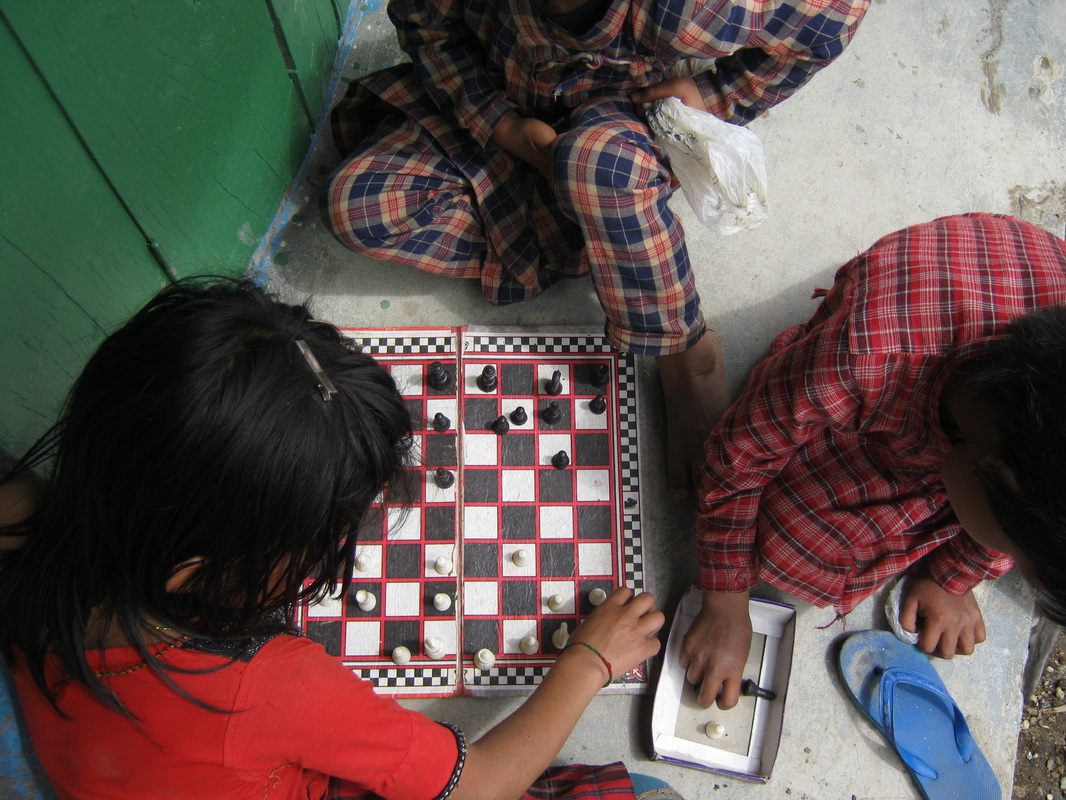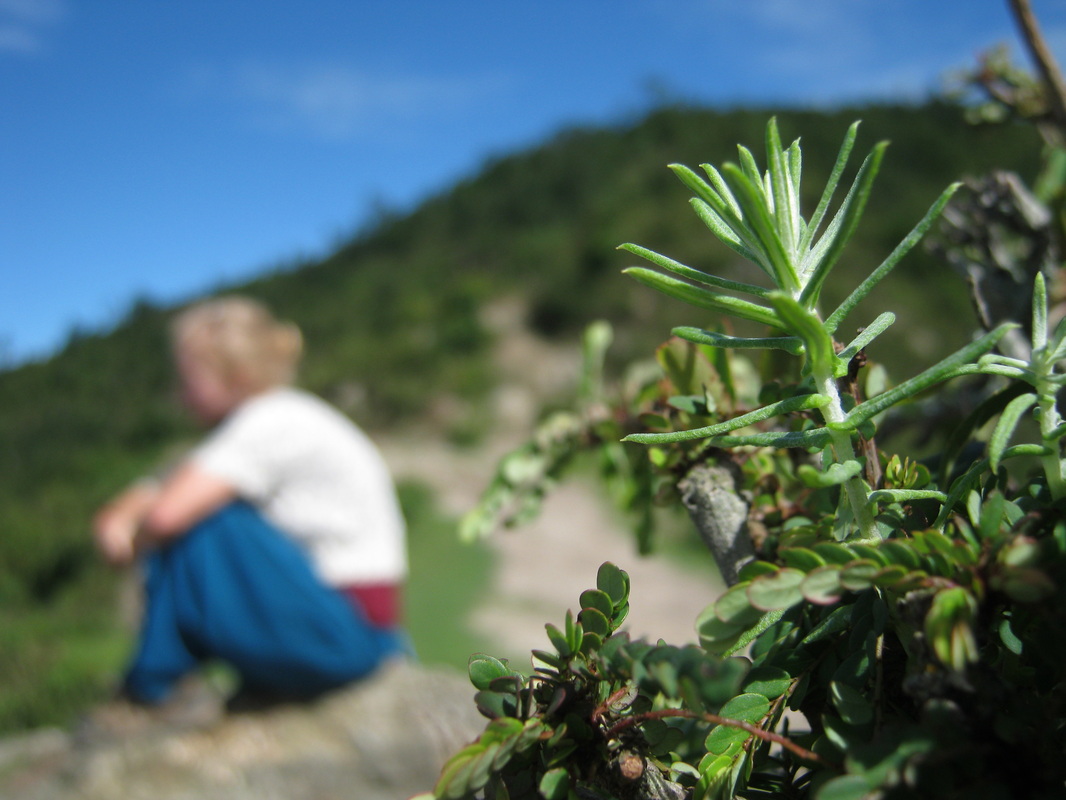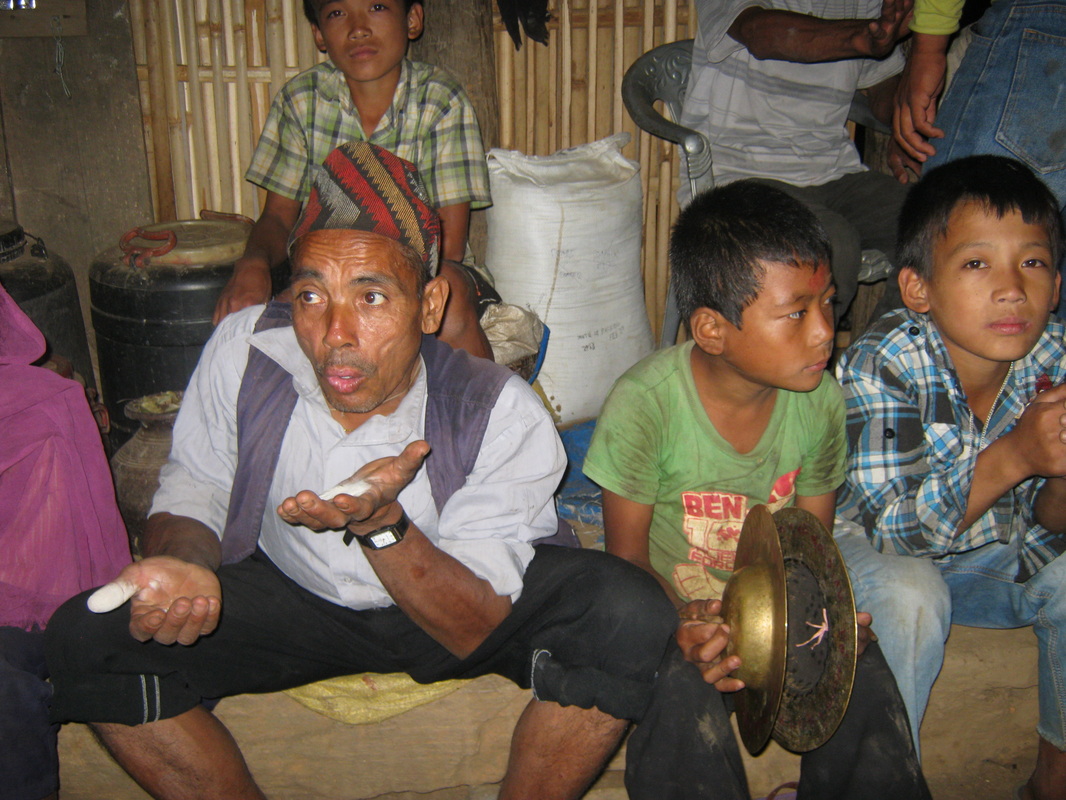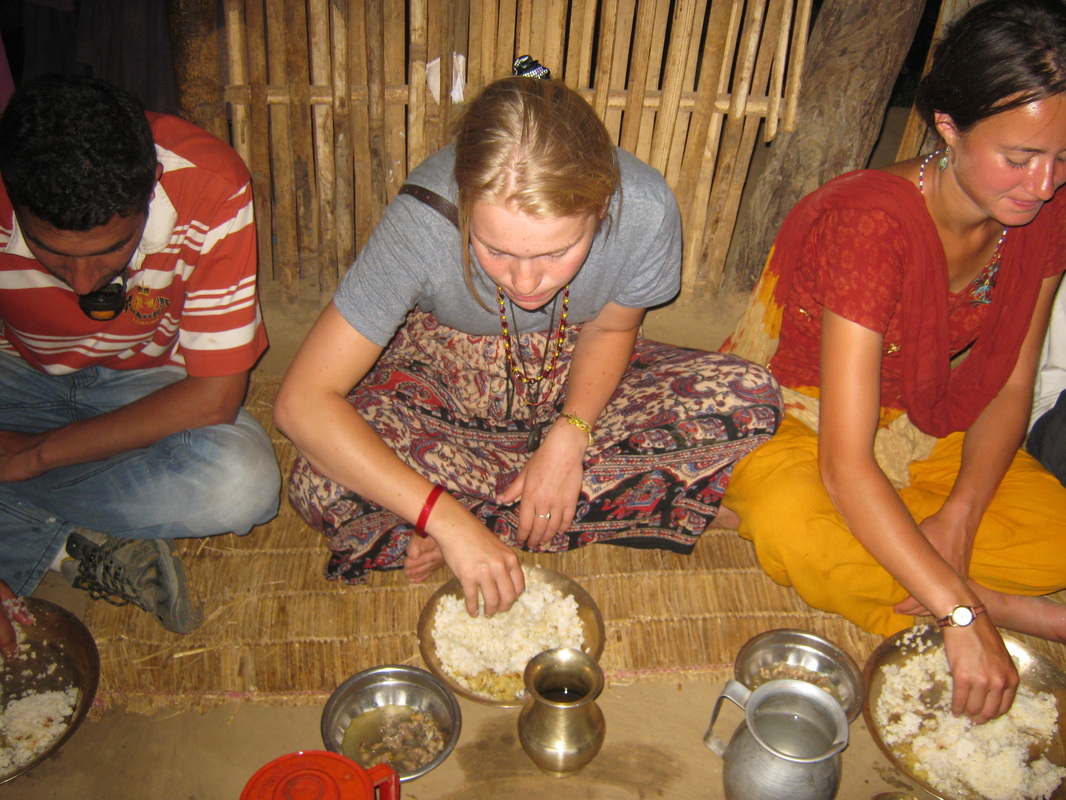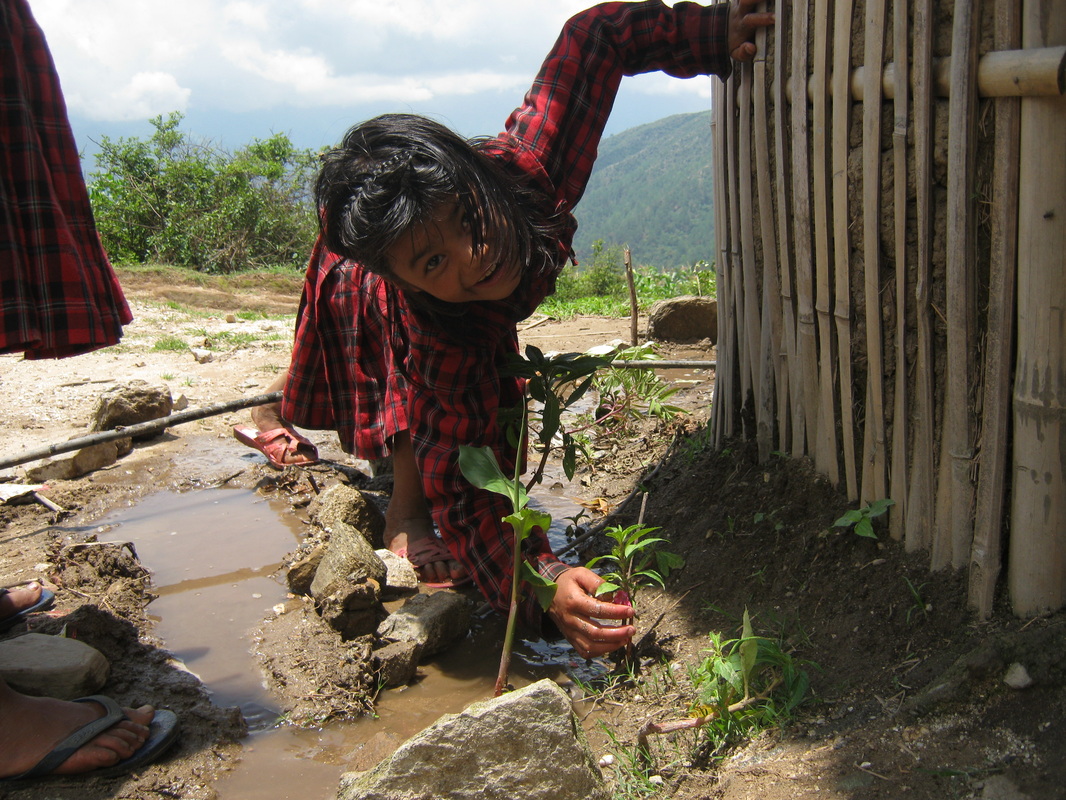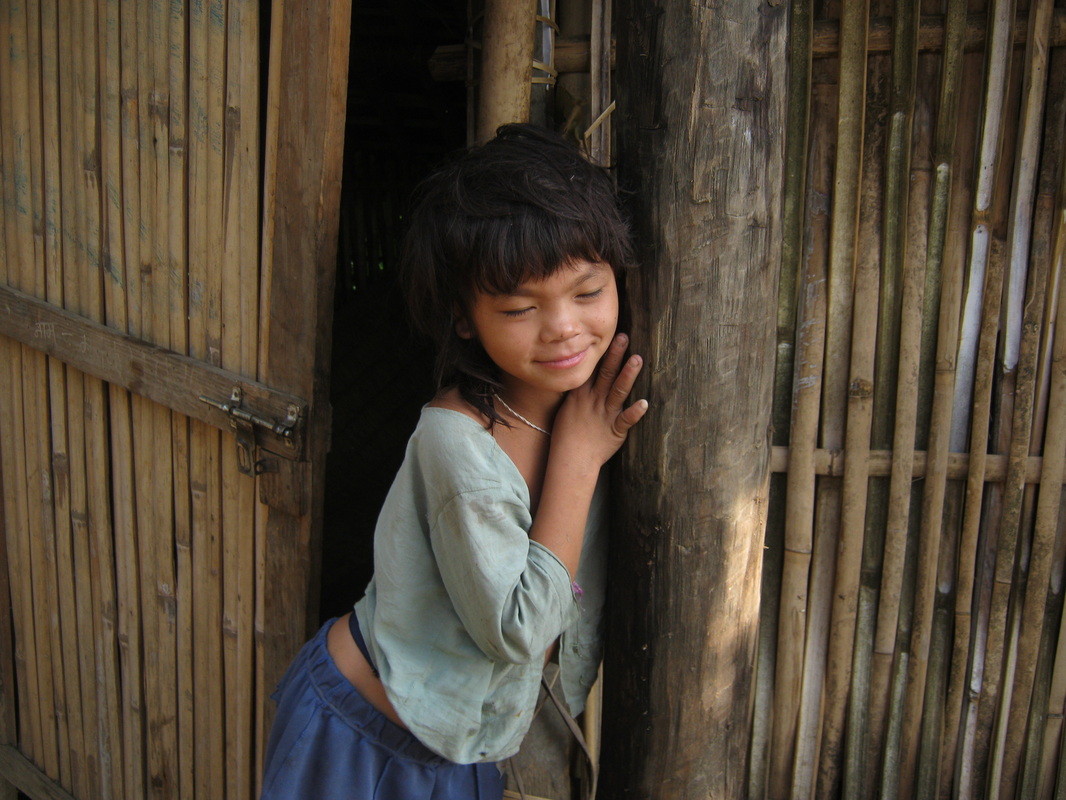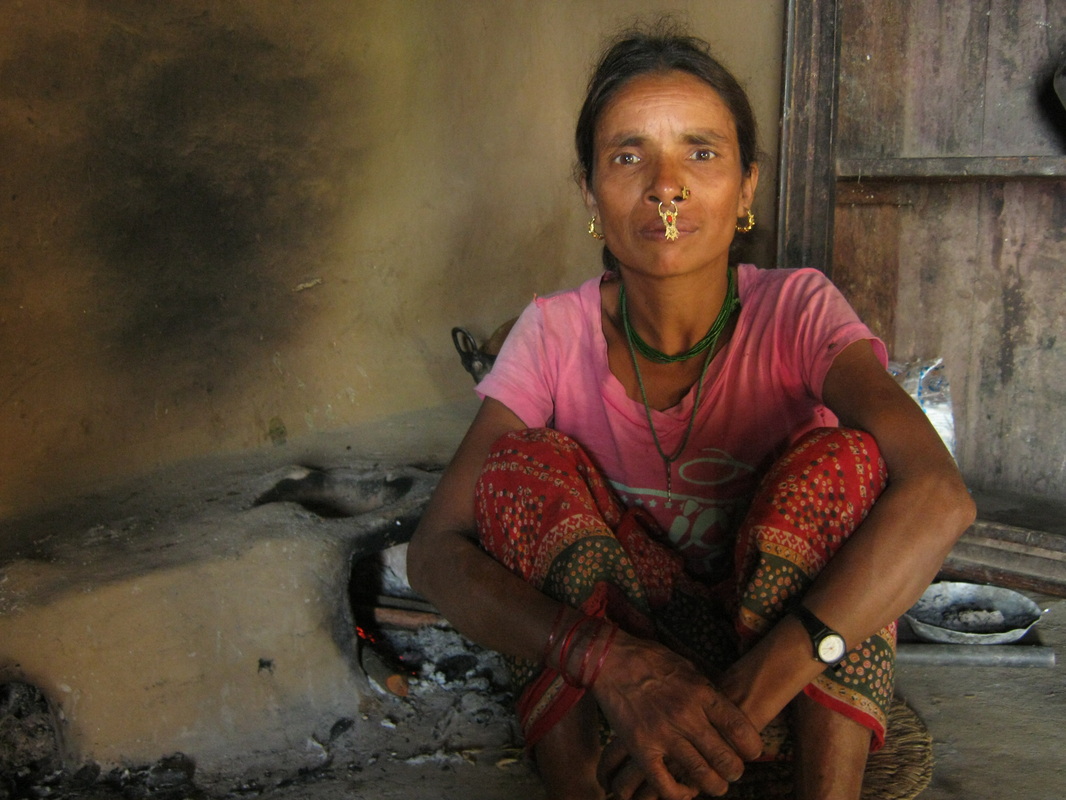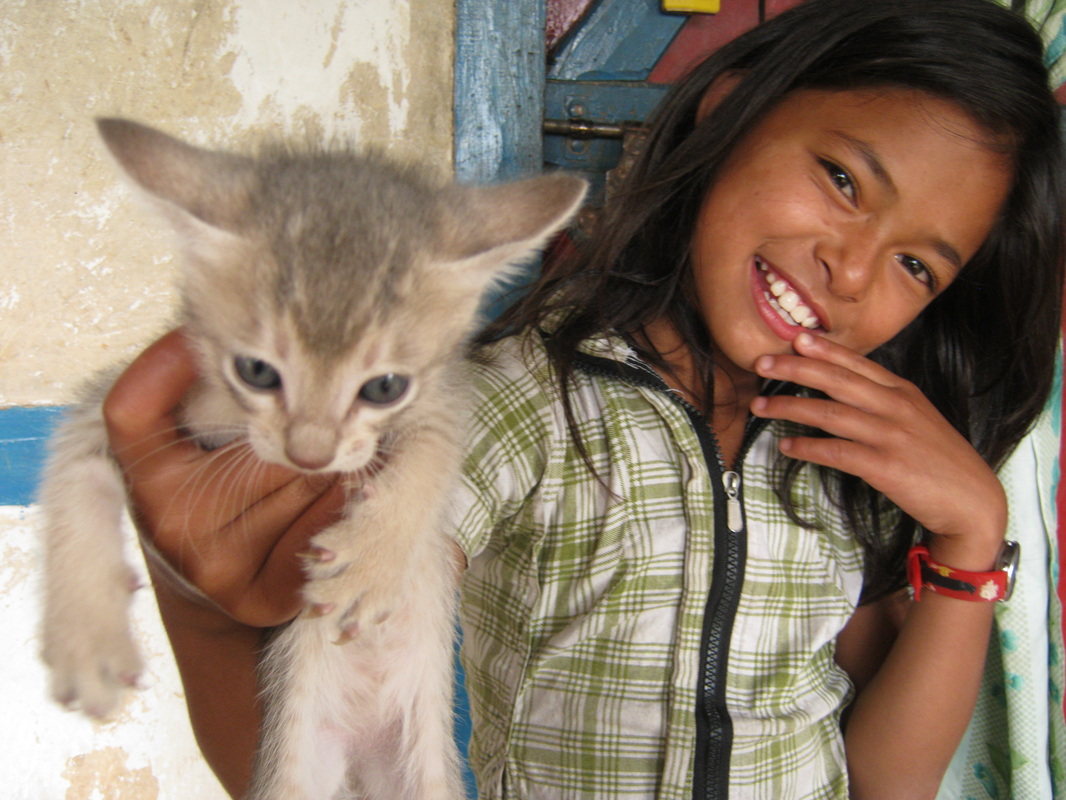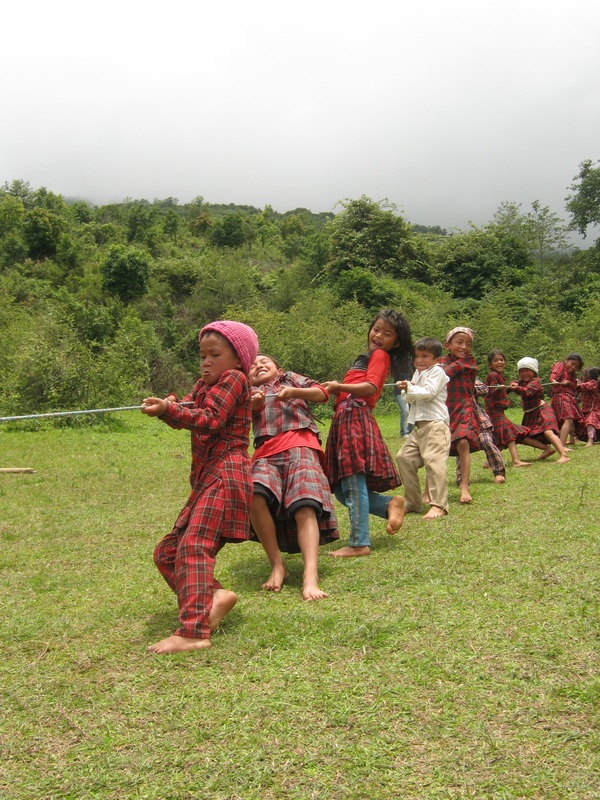AshokaU | Changemaker of the Week: Surya Karki
Co-founder Surya Karki featured on AshokaU.
The Kathmandu Post | बालमैत्री गुरु
From http://www.ekantipur.com/nepal/article/?id=5792
 तनहुँको डुम्रे बजारबाट दुई घन्टा ठाडो उकालो चढेपछि एउटा विकट गाउँ आइपुग्छ, उधिनढुंगा। गाउँको छेउमै ठूलो जंगलमा एउटा अनौपचारकि विद्यालय छ, जहाँ ढाकाको दौरा-सुरुवाल र गुन्यू-चोली लगाएका बालबालिका देखिन्छन्। उनीहरू खेल्दाखेल्दै पढिरहेका हुन्छन् र पढ्दापढ्दै खेलिरहेका।
तनहुँको डुम्रे बजारबाट दुई घन्टा ठाडो उकालो चढेपछि एउटा विकट गाउँ आइपुग्छ, उधिनढुंगा। गाउँको छेउमै ठूलो जंगलमा एउटा अनौपचारकि विद्यालय छ, जहाँ ढाकाको दौरा-सुरुवाल र गुन्यू-चोली लगाएका बालबालिका देखिन्छन्। उनीहरू खेल्दाखेल्दै पढिरहेका हुन्छन् र पढ्दापढ्दै खेलिरहेका।
खासमा यो माया युनिभर्स एकेडेमी हो। संस्थापक हुन्, मञ्जिल राना, २४। बाजेको थलो तनहुँ भए पनि काठमाडौँमा जन्मे-हुर्केका हुन् मञ्जिल। तीन वर्षअघि अमेरिकामा ह्युमन इकोलोजी पढ्दापढ्दै अमेरिकी शिक्षा प्रणालीमै खोट देखे उनले। पढाइ र व्यवहारमा पटक्कै संगति देखेनन्। त्यही बेला अमेरिकी प्रेमिकासँग पनि बिछोड भइदियो। अनि, निर्णय गरे, नेपालमै फर्किने र केही नयाँ काम गरेर देखाउने।
काठमाडौँबाट सोझै बाजेको थातथलो हानिए। गाउँको सरकारी स्कुलमा पढाउन खोजे तर ‘ओभर क्वालिफिकेसन’ भयो भन्दै मौका दिइएन। उनले आफ्नै ३० रोपनी बाँझो जग्गामा छिमेकी दलित, जनजाति, चेपाङ र अनाथ बालबालिकालाई भेला गरे। जंगलमै खेल्ने र रमाउने वातावरण तयार पारे।
मञ्जिललाई उनको शैक्षिक यात्रामा साथ दिने अरू दुई व्यक्ति छन्। भारत र अमेरकिामा पनि सँगै पढेका कोरयिन साथी सिन चुल युन र काठमाडौँ, मैतीदेवीका आशिष अधिकारी। आशिषले सेन्ट जेभियर्स कलेजबाट मास्टर्स इन सोसल वर्क सकेका हुन्। युन उनीसँगै तनहुँमा छन् भने आशिषले उदयपुरमा अर्को शाखा स्कुल सञ्चालन गरेका छन्। तनहुँ र उदयपुरमा गरी ६ देखि १२ वर्ष उमेर समूहका ९० विद्यार्थी छन्। यी बालबालिका अबको १० वर्षपछि देशका हरेक क्षेत्रमा नेतृत्व तहमा पुग्ने आशा छ उनलाई।
बिहान स्कुल पुग्नेबित्तिकै केटाकेटीहरू शिक्षकका अगाडि ठिंग उभिएर सरस्वती वन्दना गर्नुको सट्टा धीत मरुन्जेल खेल्छन्, एकअर्कालाई अंकमाल गर्छन् र कक्षामा छिर्छन्। कक्षाहरूलाई १ र २ भनेर वर्गीकरण गरिएको छैन। यसले विद्यार्थीहरूमा सानो-ठूलोको मानसिकता उत्पन्न हुनबाट रोक्ने मञ्जिल सुनाउँछन्। बरू कक्षालाई विद्यार्थीहरूको प्रकृति र व्यवहार अनुसार नाम दिइएको छ। जस्तै ः ‘मंकी क्लास’, ‘टाइगर क्लास’, ‘बियर क्लास’।
पाठ्यक्रम अन्य प्राइभेट स्कुलजस्तो भए पनि उनीहरू फरक ढंगबाट पढ्छन्। ‘ए फर एप्पल’ भन्दै स्याउको फोटो देखाउँदै पढाइ हुँदैन यहाँ। ‘ए फर अपार्टमेन्ट’ अनि विद्यार्थीलाई देखाइन्छ, खरले छाएको गाउँको पुरानो घर। यस्तो शैलीले विद्यार्थीलाई आफ्नो वास्तविकता बुझ्न सघाउने बताउँछन् मञ्जिल।
विद्यार्थीहरू स्वयंसेवी र शिक्षकसँगै निर्धक्क खेल्छन्। विद्यार्थीको आत्मबल बलियो छ। विद्यार्थीहरूले विदेशी स्वयंसेवीसँग निर्धक्क अंग्रेजीमा बहस गरेको देख्दा मञ्जिलको मन हषिर्त हुन्छ। भन्छन्, “अरू ठाउँमा पनि यस्ता विद्यालय खोल्नुपर्छ भन्ने हाम्रो सोच हो।”
मञ्जिलले बालमैत्री स्कुल चलाउन आजसम्म कसैबाट न अनुदान लिएका छन्, न लिन चाहन्छन्। निःशुल्क शिक्षा दिएबापत हरेक विद्यार्थीका अभिभावक महिनामा दुई दिन स्कुलमा आएर श्रमदान गर्छन्। शिक्षकलाई तलब दिन स्कुलले एक सयभन्दा बढी लोकल कुखुरा पालेको छ। केही बंगुर, सुंगुर र बाख्रा पनि छन्। धानखेती सुरु गरिएको छ। यसबाहेक, स्वयंसेवा गर्न आएका विदेशी विद्यार्थीसँग मासिक दुई सय डलर लिन्छन्। उदयपुरमा अग्र्यानिक खेती गर्ने र सस्तो होस्टल सञ्चालन गर्ने तयारी भइरहेको उनको भनाइ छ।
विद्यार्थीहरू आफ्ना शिक्षकसँग घुमिरहन्छन्। तनहुँका विद्यार्थी उदयपुर जान्छन् भने उदयपुरका तनहुँ। यसलाई भिन्न स्थान र परिवेशमा हुर्केका केटाकेटीहरूबीच स्थानीय भाषा र संस्कृति बुझ्ने अवसरका रूपमा लिन्छन् मञ्जिल। उनी आफ्नै मिहिनेत र सीपलाई लागू गर्न पाएकामा खुसी छन्। भन्छन्, “उता पढेर ठूलो संस्थाको जागिर खाएको भए पैसा त कमाउँथेँ होला। तर, सन्तुष्टि अवश्य पाउँदिनथेँ।”
Turn on your radio, turn on your radio
Read original on weikesadventurousadventures.weebly.com.
Have you ever been so completely out of touch with the modern world that you have no internet, no phone, not even a lamp to read a book by? Just the light of the skinny winny candles that you can buy in the local shop to make your evening last a little longer than 7 ‘o clock. I’m sure you have. But for me, it was the first time that I was staying in a place so remote from everything.I spent the last month in Udayapur, another Maya school in yet another district (they are spreading quite quickly-3 schools now), in a little village which -coincidentally- is also called Chisapani. The nearest town, Gaighat, is 4 hours down the hill by bus but in monsoon season you never know whether the bus will be running at all.
Remember the Udayapur kids I wrote about a few blogpost ago, who left to go back to their home after staying two months in the Tanahu school? Well, I went after them.
It was a wonderful welcome. After riding the bus up for some 5 hours (the last bus which went up all the way, lucky me-especially since I brought loads of school books) I got out at a Chisapani, and I discovered that nobody was there. It was almost nightfall. So I put down my bags and was just thinking where the school would be, when I heard my name being called ‘Weike miss!’. From afar I see Buddhap and Ramesh running my way.
‘Weike miss you are going to my house, ok?’ Buddhap says, ‘we have a party tonight!’. They showed me the house were I should put my stuff and off I went, into the darkening night with Buddhap and Ramesh on both my hands. After a few minutes we passed another village, and Roshani, Kamala and Regina (who turned out to be neighbors) come running out of their houses to give me a lot of big overwhelming and very happy hugs. As I’m trying to struggle myself loose from all the loving children, I see Rikke, Becky and Ashis Dai, the two volunteers and current ‘boss’ of this school, standing a bit further away.
Parties are there to be had, so a few minutes later all of us- the volunteers being led by the two children- set out for Buddhap’s house. Which turned out to be two hours away, halfway down the mountain.
Me, Becky and Ashis Dai eating some sunghur ko masu (pig meat)
But enough about parties and meat, how was the school, you ask? Well, the problem I have right now, after one month of no internet and no electricity, how do I start? One month is a lot of time to tell in one blog post, and to be fair, a lot always happens in a month’s time.
The school is wonderful. I was so happy to see these kids again, who I’ve lived with for two months in Tanahu, and they were (I hope, at least) also very happy to see me. But there is more. New admission ‘happened’ two months ago, so in addition to the 15 students that I already knew, there were some 30 more to get to know. And what students they are.
If I thought that Tanahu children were ‘rough’, Udayapur children are even more used to hard work, and they are probably ten times crazier too.
These kids really know how to make me smile. Imagine, I’m giving class, serious english class, and there’s a slug sliming its way up the clay wall of the classroom. ‘Look miss,’ Nishan says,’I eat slug, ok?’ and with one big gulp he swallows the slimy creature, after which he smiles at me broadly. ‘Tasty?’ I ask, and he nodds happily. ‘Another one!’ someone says, and as Nishan reaches for it to eat it I just manage to take it from his hand. ‘No eating during class’, I say.
Another class. French class to the A-class. I’m teaching them sentences that might be useful for them. ‘Je peux boire quelque chose?’ (can I drink something?), Je peux aller a la toilette (can I go to the toilet?) when Komala asks: ‘ Miss, how do you say ‘can I spit’ in French?’. I look it up in the dictionary. ‘Je peux cracher’, I say. ‘Madame, je peux cracher?’ she asks me. Smilingly I answer ‘bien sur’ and she goes outside to spit a nice flume on the pebble street. Then, excited by this new word, all the kids ask me the same question, and after class the street is covered with all different shades of spit. Lovely.
The B-class kids planting flowers next to their classroom
I love these kids, I love teaching, but I’m sure that if I only write about how wonderful teaching is you will not be reading this blog very much (neither would I) so I will see what else happened.
Thing is: There is no children boarding at this school, so after 4 o clock you’re pretty much free to do anything you want. Anything. You can play chess. You can read a book. You can gather firewood. You can cut firewood. You can build something out of bamboo. You can write in your journal. You can drink roxy. You can cook dinner, or go to one of the canteens and have someone cook dinner for you. And, most of all, you can listen to the radio.
Ashis dai and his radio are inseparable. After being in this village for the past three months or so he developed a routine of waking up with the radio, and going to sleep with it (many a night I heard him say ‘hajur, hajur’, to whatever the newsreporter had to say). By now, I know all the songs and advertisements of Kantipur FM. ‘Turn on your radio, turn on your radio, the sweet sounds you hear everywhere that you go, on your radioooo’.
Sometimes only books and radio wasn’t enough and I would get a kick out of just leaving with some of the children after school and sleep at their houses. By now, I’ve slept at Buddhaps, Parbatis, Kamalas and Roshanis house, which is always absolutely wonderful and interesting, too. Parbati, for example, didn’t even turn out to have a house at all when she invited me. Just a bamboo hut. I can sleep anywhere happily, bamboo hut or fancy hotel alike, but it just surprised me because Parbati is soo rich of mind, I expected her to be rich in means too. Me and my assumptions.
Tug of war during sports day
Anyway, time to go, I will write more about Udayapur when I go there again in a week, with my mom who arrived in Kathmandu two days ago. Hello mom:)
All pictures courtesy of weikesadventurousadventures.weebly.com.
Indiegogo | Advocacy Training Program in Nepal
Recently Surya Karki held a crowdfunding campaign on Indiegogo. He managed to raise the funds and will be teaching effective advocacy techniques to the educators and administrators of Maya Universe Academy in Nepal. Keep posted to this blog for updates on this project.
BEdition Magazine | Bearing Witness to Global Citizenship Education in Nepal
From http://beditionmagazine.com/bearing-witness-to-global-citizenship-education-in-nepal/. By Shelane Jorgenson, PhD candidate, ’09 MEd, ’05 BA
Climbing up the mountain to Maya Universe Academy (MUA) is like entering a different time and space. Not in the past, as you might imagine a small rural school in the Tanahun District of Central Nepal to be, but rather the future. As a Doctoral candidate in Educational Policy Studies at the University of Alberta, Canada, I have studied and observed education systems around the world, but no form of education has captured my heart to the extent of MUA in the village of Udhin Dhunga, Nepal has. Though I spent only a few days at the school, I was greeted with open arms of the staff, volunteers, students and broader community like I was a family member returning home. It was not by any plan or aspiration to go to the school that I ended up there, but by some divine karmic path to show me the potential of education.
After spending a month at Oneness University in India, I came to Nepal at the beginning of May to visit a friend in Kathmandu whom I had met on a flight 13 years ago. In accordance with extraordinary Nepali hospitality, I was welcomed into the family and a seemingly endless network of family and friends that have guided and accompanied my journey. Knowing that I am interested in education, my friend set up an opportunity for me to visit MUA, which was started by his nephew, Manjil Rana in 2010. The Academy, which I learned is the first and only free non-government school in Nepal, is a non-profit, community and volunteer-run organization with about 60 students and growing daily. In response to the growing number of enrollments and seeing the need for free non-government education in other regions of the country, two more schools have since opened. One in the rural village of Chisapani, and another in the Syangja district of Nepal.
Maya, which means love or friendship, is a perfect depiction of the energy and spirit of MUA. After the long journey to the school (about a 5 hour bus ride, one hour jeep ride and one hour hike up a mountain) from Kathmandu, I was instantly welcomed with smiles and conversation with the children, foreign volunteers and devout staff that work tirelessly to maintain and sustain the operation and vision of MUA. The mission of the Academy is to “embrace social responsibility and creative-mindfulness to educate and inspire our students and their families to build community, gain greater independence, and transform their lives.” A tall order for a rural school operating on revolving door of volunteers, few staff and little funding. If you were to tell me a month ago that a school in a rural village in Nepal is providing free education, and in some cases boarding, to underprivileged kids without any government or NGO funding base, I would not have believed you. However, in three days, my world and ideas about education were forever altered.
The most integral insight I gleaned in three days was about passion and compassion. MUA was developed through the compassionate heart of its founders. Recognizing the deficiencies of government schools that were not meeting the needs of students and unaffordability of private schools, which are unattainable to the majority of Nepalese people, the founders saw a need for quality education that was also free of cost. Their compassion for underprivileged children and providing them with equal opportunities for quality primary education, called upon a network of local and international volunteers to make their vision a reality. It is with great passion that I see volunteers and staff working to sustain this vision. In order to make this a reality, families of MUA students are asked to volunteer two days a month undertaking tasks such as building classrooms, cooking, gardening and daycare in exchange for their children’s education. Everywhere I looked, there were educational spaces being opened through informal learning. Foreign volunteers were learning how to speak Nepali, how to build classrooms and toilets using local knowledge and materials, local gardening, farming, cooking techniques and more. Reciprocally, the local Maya community was learning from the experience and knowledge of its foreign volunteers. While I was at MAU, French and Theatre classes were developed and delivered by two young French volunteers based on their knowledge and experience being theatre majors in their home university. Mutual and reciprocal learning from the local to the global fuels growth for all Mayan community members in multiple ways- personal, intellectual, community and spiritual. I have never in my life seen such a committed and passionate group of volunteers, whose hearts and spirit are intrinsically tied to the Maya community.
The local and global connections of inter-cultural education are the subject of my doctoral research. As people from different parts of the world come together, there are tremendous possibilities for global citizenship- some encouraging for the potential of interactions to foster relationships and care for others beyond borders, but there are also risks in the ways that knowledge transmission is undertaken. I have come across too many educational programs that foster a one-way traffic of privileged North American or European students traveling to the global south to embark on a short international visit and returning home without learning the language or ways of their hosts. Global citizenship emerging from such one-way practices perpetuates many of the colonial trends that maintain inequitable power relations. The global citizenship education that I bore witness to at MUA was possibly the most genuine and encouraging that I have had the privilege to encounter. Maya students, most who have never been beyond the hills of their village, are receiving a global education that the volunteers from countries such as Holland, Malta, Malaysia and Korea, are bringing to their lives inside and outside of the classroom. Reciprocally, the foreign volunteers are learning and living the reality of a remote mountain village, where water is fetched daily from a nearby spring, eating food that one grows and is cooked on an open fire, and as one volunteer stated, “having little access to the outside world,” without internet or other media readily available. Yet, in the world of MUA, the conditions of rural living are embraced with great cooperation and humility. Everyone, learning, growing, becoming global citizens.
The community of Dhunga recognizes the power of education and the wonderful opportunities that are afforded to their children at no monetary cost. This is reflected in continual requests for enrollment and parents showing up more than their required 2 days to volunteer. As the Mayan community grows to meet this demand through increased registration, expanding schools, hiring staff and hosting volunteers, donations to sustain their vision and dream are paramount. If you want to be involved and support the Mayan community to educate and inspire students, their families and volunteers for social development and fostering global citizenship, please visit http://mischwald.ch/mayauniverseacademy/get-involved.
The Kathmandu Post | Portrait
Chairman Rana featured in The Kathmandu Post.
 Read full article → http://epaper.ekantipur.com/ktpost/showtext.aspx?boxid=1327962&parentid=24026&issuedate=2962013
Read full article → http://epaper.ekantipur.com/ktpost/showtext.aspx?boxid=1327962&parentid=24026&issuedate=2962013
Resilience | How a gift economy powers education in rural Nepal
Students and their parents, foreign volunteers and Maya founders work to make the Maya Universe Academy self-sustainable through farming and food production on the schools’ lands.
In recent months, I have worked a lot with currencies, as I’m involved with Dropis, a team of developers, researchers, and designers dedicated to creating a currency for the sharing economy. So, when I came across “Love is our Currency,” a TEDx talk by Manjil Rana, cofounder and president of Maya Universe Academy, my curiosity was piqued:
I was impressed with the video, and their gift economy model was exciting. The founders aimed to create a self-sustaining system to support quality education for children in Nepal’s rural areas. Impressive. Right after watching the talk, I got in touch with Manjil and asked to meet him in Kathmandù to get more details.
As the Maya (meaning “love” in Nepali) Universe Academy proves, love for your community and passion for solving real community problems can be new forms of currency—a new means of exchange that generate impressive changes for good.
Entrepreneurship in a Country with Systemic Crises
I landed in Nepal, eager to see the country and meet these amazing people. By the end of the first day, I hadn’t met with Manjil, as he was needed at Damauli School. But over the phone, he put me in contact with Prabesh KC, his cofounder.
I met Prabesh over a cup of tea, along with Prayas Cheetri, Maya’s IT person. They were in Kathmandu to buy some machinery for the production of juices and jams. The fruit for these products came from the lush banana and orange plantations the communities created at the various sites that now make up the Maya Universe.

Prabesh, me and Prayas in Kathmandu.
The chat with Prabesh and Prayas confirmed my impressions: Nepal is a wonderful country, but plagued by enormous social and political problems. A weak democracy, born after years of civil war, was recently threatened by the inability of parties to agree on a shared vision and the political climate is still unstable. The distance between the Nepalese people and the government is abysmal.
The first thing Prabesh told me was that quality education — both elementary and higher — is limited, if not absent, in Nepal. That was why he and Manjil spent most of their lives as students abroad, mainly in India.
At the end of their studies in anthropology (Manjil) and social business (Prabesh), the two felt very little excitement about creating a traditional business, or in working abroad for a corporation. Instead, they were aware of the enormous problems facing education in their country and decided to devote their themselves to finding a solution.
They resolved to challenge the government by showing that the quality of education provided to children, especially in rural areas of Nepal, was so low that they can do better with little or no resources.
Manjil owned a piece of land in the county of Damauli. It was here that Manjil, Prabesh, and Yoon from Korea began, literally, from inside a tent.

The very first “classroom” during a monsoon rain.
From Loans to Self-sustaining Social Enterprise
In the beginning, the school survived only through the support of friends, but soon infrastructure and more organization was needed. Incredibly enough, the guys were able to obtain bank loans to support their project by using family property as collateral. Although this helped the team to leave the tents and build better facilities, it strained family relationships.
These events instigated the entrepreneurial mindset of the team. From the very beginning, Maya Universe Academy started experimenting diverse models with the aim of making the effort self-sustaining.
Since the most accessible resource they had was land, they started with growing bananas and oranges and breeding pigs, chickens, and ducks.
In communities where schools were established, it did not take long for the villagers to understand the value of the project, and soon they began contributing — especially those whose children were attending the new schools.
These skills and labor exchanges are at the core of the project. This gift economy sustains the enterprise.

One of the current school buildings.
Explaining the Economic Model
Admittance at Maya Schools is effectively free, which makes them the first free private schools recognized by the government of Nepal.
In exchange for the children’s admittance, the parents work two days per month in operations. They contribute to the production process (eg: farming), or just help with facility construction and other needs.
As production is still not mature enough to make the full monthly bank loan payment (though it covers most needs), Maya asks volunteers visiting the schools to pay approximately $200 per month for food and shelter. This is the only money coming into Maya for now. The aim of the team is to eliminate the need for this funding source, which should be possible when production ramps up.
The founders’ vision is to avoid NGO funding, as it is not always transparent, and to operate solely on a self-sustaining model. These educational communities should be strong enough to hold their own in the long term, and create skilled and educated workers. This system repurposes the often under-utilized skills of the villagers, who are farmers, ranchers, and foremen, to ensure a very basic need: a good education for children who will eventually become key players in local development.

The Impacts of Maya on Communities
Today, the project educates more than 80 children, from six to 11 years old, in three villages (Damauli, Sagarmatha, Syanja). Word of mouth spreads very quickly, and numerous requests have been made for Maya to open new schools.
The quality of education Maya provides is more respected than the government-backed schools. Older children coming from government-backed schools must start in a lower-grade class in order to catch up.
The impact of the Maya schools is so positive that the local government schools have increased the quality of education out of fear of losing students to Maya.

Manijl and Prabesh with some students and foreign teachers.
Looking Out for Love
Discussing the future of Maya with the cofounders, it became clearer to me how projects like Open Source Ecology will be important in the future. For example, an open source approach could be used by Maya to build the jam and juice canning machines. This would be a more cost-effective solution than buying pre-made industrial machinery, but is still not feasible due to cost.
The daily life of Maya consists of experimenting with new ways to create wealth, and this reminded me a lot of the lean approach of hackers, which emphasizes continuous experimentation and iterative design. Both are key to the “changemaker” movement. I referred to this in a recent Shareable article.
What Can be Learned from Maya
When I arrived in Nepal, I was hoping to learn how a local community creates wealth and a more meaningful life. By the time I left Nepal, I had a lot of ideas and inspiration.
I’ve learned that gift economies could have a big positive impact on local communities. Maya’s work suggests that supporting social enterprises with the production of tangible wealth (like agricultural products) can work, and even teach the “rich” West a lesson. Those who wonder how to make sense of their lives and skills can take a cue from these men in Nepal who created something important to help their community.
Volunteering in one of Maya schools is not only an enriching experience, but could teach you a lot about how to organize sharing projects in your own community. Nepal is not the only country in crisis; we should all evaluate new economic models, and focus on our own communities.
Follow me on @meedabyte, and get in touch if you want more information about Maya.
 Maya Universe Academy, Nepal
Maya Universe Academy, Nepal


